Abstract
In order to achieve collinear phase-matched nonlinear optical frequency conversion in cubic crystals, a novel method to induce and modulate the birefringence based on the linear electro-optic effect was studied. Taking terahertz generation with ZnTe and CdTe crystals of the point group as an example, an external electric field provided the freedom to realize perfect phase matching (PM) in a wide bandwidth up to 2 THz for difference frequency generation, with monochromatic optical waves at around 800 nm and 1010 nm, respectively. Theoretical simulations showed that such a method helps to extend the terahertz frequency, enhance the conversion efficiency, and alleviate the limitation on the pump wavelength, which is highly favorable for nonlinear optical uses of cubic crystals. Simultaneous wideband terahertz generation pumped by ultrashort laser pulses via optical rectification or difference frequency mixing was also discussed, indicating that an electric field can be used to modulate the PM characteristics without changing the group velocity-matching condition. Tuning the nonlinear interaction by an applied voltage is fast, robust, and convenient compared to other approaches. In addition, the linear electro-optic effect can make the nonlinear crystal a compact and high-speed terahertz amplitude modulator, which has great potential in radar, communication, imaging, etc.
1. Introduction
Cubic nonlinear crystals represented by zinc-blende semiconductors, such as GaAs, GaP, ZnSe, ZnTe, etc., possess large second-order nonlinearity and a wide transparent range; thus, they are of great significance in nonlinear optics for generating mid- to long-wave infrared and terahertz waves [1,2,3,4,5]. In nonlinear processes, phase matching (PM) plays a central role in determining the general characteristics [6]. It governs whether the maximum efficiency can be achieved and dictates the wavelength tuning bandwidth. PM requires the interacting optical waves to have specific relationships of velocity or the refractive index in nonlinear materials. However, zinc-blende crystals are cubic and isotropic in their linear properties, so there is great difficulty in fulfilling the PM conditions without birefringence. Wideband tunable frequency conversion is even harder because of the lack of approaches for varying the refractive indices. In order to guarantee reasonable efficiency and bandwidth in nonlinear frequency conversions, the phase mismatch can be compensated for by introducing anomalous dispersion. Noncollinear interaction can be used for wavelength tuning [5,6,7,8,9,10], but the complexity and overlapping of the degraded beam limit its applications [9]. On the other hand, quasi-phase matching (QPM) becomes practical with the development of epitaxial methods for growing periodically inverted GaAs and GaP crystals, where efficient frequency conversion extending to the mid-infrared and terahertz band has been achieved [11,12,13,14,15]. However, the QPM method still cannot be used for II–VI semiconductors, such as ZnSe and ZnTe, as modulating their domain orientations is extremely difficult.
A completely new idea to achieve PM in cubic nonlinear crystals is artificially introducing birefringence via the linear electro-optic effect. PM using the linear electro-optic effect was first proposed by Cui et al. [16], where the main purpose was to stabilize the frequency conversion process by accurately controlling the refractive index of a nonlinear crystal via introducing an external electric field. The refractive index ellipsoid can be changed by the applied electric field, causing the rotation of the principal axes and the formation of new principal indices. As a result, cubic nonlinear crystals become anisotropic and birefringence appears. The induced birefringence is related to the applied field; thus, the PM condition can be tuned via the voltage. Moreover, angle tuning in a birefringent crystal becomes possible and can be used to extend the wavelength range. Therefore, the linear electro-optic effect provides a simple and practical approach to realize wideband collinear PM for cubic nonlinear crystals.
In this paper, PM conditions enabled by the linear electro-optic effect that allow for terahertz generation in cubic nonlinear crystals were studied for the first time. Theoretical simulations were performed on the difference frequency generation (DFG) and optical rectification (OR) in ZnTe and CdTe crystals, which have high second-order nonlinearities and large electro-optic coefficients. The results indicate that collinear perfect PM can be achieved in an unprecedented wide frequency range, up to 2 THz, in bulk crystals by voltage tuning. In addition, the simultaneous wideband terahertz spectrum could be generated and optimized by tuning the PM conditions of specific polarizations of an arbitrary pump wavelength. Considering the additional advantages of agile tuning, large acceptance, etc., the PM method based on the linear electro-optic effect has extensive application prospects for improving the performance of nonlinear optical frequency conversion.
2. Theoretical Methods
2.1. Collinear Phase Matching in ZnTe and CdTe
Both the ZnTe and CdTe crystals belong to the point group with a high symmetry. Because of their cubic structure, the refractive index is independent of orientation. Considering a collinear three-wave DFG interaction that exhibits normal dispersion with ω1 > ω2 ≥ ω3 for angular frequencies and n1 > n2 ≥ n3 for refractive indices, the phase mismatch is
where c is the speed of light in a vacuum; k1, k2, and k3 are scalar wave vectors; and the energy conservation condition ω1 = ω2 + ω3 is included. Since n1 > n2 and n1 > n3, the overall expression of Equation (1) is always positive, meaning that Δk > 0 is strictly fulfilled. The noncollinear geometry does not help, as it makes Δk larger.
However, if anomalous dispersion exists, e.g., two incident infrared waves k1 and k2 generate terahertz wave k3 (kT) across the reststrahlen band, n3 (nT) can be much higher than n1, which provides the possibility of Δk > 0 at certain frequencies. The ZnTe crystal has a considerable coherence length, around 825 nm at 1 THz, which corresponds to a wide terahertz bandwidth [17], while the CdTe is more suitable for pumping around 1050 nm to allow effective collinear DFG [18]. The relative PM efficiency is defined as
The value of ηPM indicates how a particular DFG process compares to one under perfect PM conditions. Assuming the crystal length is L = 5 mm, the relative PM efficiency is calculated and shown in Figure 1. The pump wavelength ranges in consideration are 700–900 nm and 950–1150 nm for ZnTe and CdTe, most of which can be obtained by tunable Ti:Sapphire lasers and Yb-doped fiber lasers, respectively. The refractive indices involved have been validated for both near-infrared and terahertz waves [19,20].
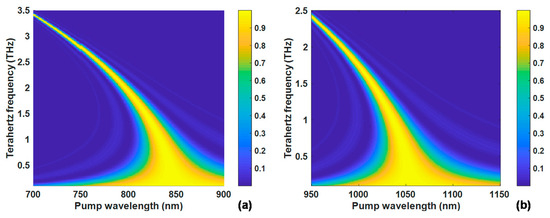
Figure 1.
Relative PM efficiency of collinear DFG in ZnTe and CdTe crystals: (a) ZnTe and (b) CdTe.
It can be seen in Figure 1 that both ZnTe and CdTe allow for a high DFG conversion efficiency to generate terahertz waves by employing appropriate pumping wavelengths. Nevertheless, perfect PM (ηPM = 1) is more the exception than the rule and it cannot be met for the whole wavelength range, even though sometimes the degradation is quite smooth and the bandwidth is large. On the other hand, it is impossible to vary the PM condition by tuning the interaction orientation for these cubic crystals. Therefore, the performance for generating tunable terahertz waves via DFG is severely limited, especially with longer nonlinear crystals.
2.2. Electro-Optic Phase Matching: Basic Concept
The linear electro-optic coefficient matrix for nonlinear crystals of the point group has non-zero elements γ41 = γ52 = γ63 (γ41 = 4.04 pm/V for ZnTe and γ41 = 4.5 pm/V for CdTe) [21]. Considering the configuration shown in Figure 2a, the DFG process occurs under the pumping of two optical beams, k1 and k2, which propagate along the [110] crystallographic direction with orthogonal polarizations [001] and [], respectively. The polarization of the generated terahertz wave (kT) is along the [] direction. In this case, the effective nonlinear coefficient is deff = d41 (d41 = 68.5 pm/V for ZnTe and d41 = 81.8 pm/V for CdTe [22]).
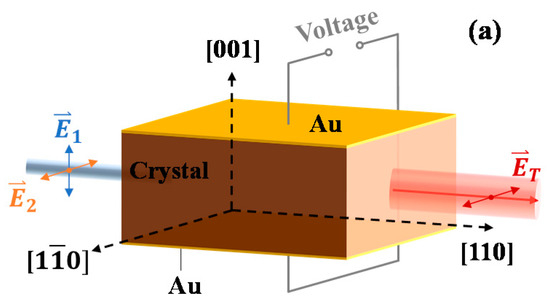
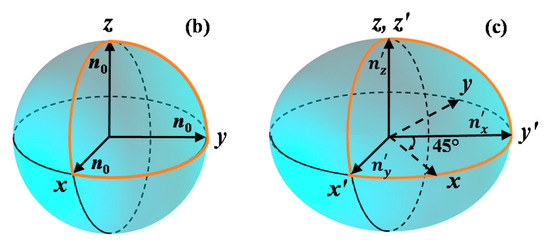
Figure 2.
The DFG configuration in crystals of the point group: (a) electric field, optical beam propagation, and polarization directions; (b,c) the refractive index ellipsoids before and after applying the electric field along the z axis. The Au planar electrodes are coated to generate a uniform electric field along the [001] direction.
When an electric field is applied along the optical axis (z or [001]), the refractive index ellipsoid rotates about the z axis by 45° and the crystal becomes biaxial. The variation in the refractive index ellipsoid is shown in Figure 2b,c, where the principal axes x′, y′, and z′ are in the [], [110], and [001] directions, respectively. If the principal refractive indices before applying the electric field are nx = ny = nz = n0, the new principal indices with an electric field E along the z axis are
in which x, y, and z represent the three principal axes. E = U/d, where U is the voltage and d is the crystal thickness along the electric field.
Then, the problem turns into seeking the PM condition in a biaxial crystal along the y’ axis. Unlike classical birefringent PM, which relies on tuning the orientation or temperature of the nonlinear crystal, the birefringence here is varied by changing the electric field. Since the electro-optic coefficient is in the order of pm/V, an extremely high voltage is usually required to change the refractive index significantly, or the thickness should be severely restricted. However, under the condition of a small phase mismatch, e.g., the cases shown in Figure 1, perfect PM can be practically fulfilled by the electro-optic effect.
3. Results and Discussion
3.1. Widely Tunable Collinear Phase-Matched Monochromatic Terahertz Generation Via the Electro-optic Effect
Given that the breakdown voltage is around 20 MV/m for ZnTe and CdTe and the crystal thickness d is assumed to be 3 mm, the maximum applied voltage |Umax| is 9 kV. Figure 3a,b give the maximum relative PM efficiency ηPM achievable by applying suitable electric fields within the breakdown voltage. Obviously, the collinear PM (ηPM ≥ 0.5) ranges are greatly extended by applying a suitable voltage. Firstly, the tolerance of the pump wavelength is significantly improved. Taking the generation of a terahertz wave at 1 THz as an example, the feasible pump wavelength covers the ranges of 789–884 nm and 1004–1074 nm for ZnTe (Figure 3c) and CdTe (Figure 3d) crystals, respectively, compared with those of 818–850 nm and 1024–1050 nm without the electric fields. Secondly, the achievable terahertz frequency range becomes much broader. For the ZnTe crystal pumping at 800 nm, collinear PM allows effective DFG to generate terahertz waves of 0.1–2.25 THz (Figure 3e) by tuning the voltage, while the range is limited to 0.1–0.34 THz and 1.74–2.05 THz if the electric field is removed (Figure 1a). For the case of CdTe pumping at 1010 nm, a phase-matched continuous terahertz tuning range of 0.1–1.84 THz (Figure 3f) can be realized by applying an electric field. It should be noted that the electric field provides an extra degree of freedom to fulfill perfect PM (ηPM = 1), successfully expanding such a region from a line in Figure 1 to a broad area in Figure 3. Therefore, the electro-optic effect not only extends the PM range, but also greatly improves the efficiency ηPM.
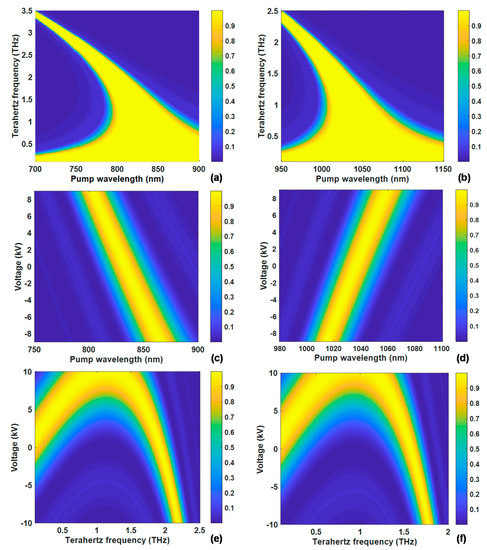
Figure 3.
Relative PM efficiency of widely tunable monochromatic terahertz generation by collinear PM in ZnTe and CdTe crystals via the electro-optic effect: (a,c,e) are for ZnTe; (b,d,f) are for CdTe; (a,b) show the perfect PM regions by applying a suitable voltage; (c,d) demonstrate the relationship between voltage and pump wavelength for phase-matched 1 THz generation; and (e,f) represent the relationship between voltage and terahertz frequency with fixed pump wavelengths of 800 nm and 1010 nm, respectively.
An extra advantage of tuning the PM efficiency by the electro-optic effect is that the conversion efficiency can be rapidly changed for a special three-wave interaction process following an arbitrary preset function. This promotes an effective terahertz modulator in addition to a generator. For example, the ZnTe crystal allows a modulation depth of over 90% at 1 THz when the applied voltage varies from 2.4 to 9 kV. The modulation voltage can be proportionally decreased if thinner crystals are used. Such compact and high-speed multi-functional devices should have great significance in various applications.
Since the homogeneous isotropic ZnTe and CdTe crystals are transformed to be biaxial by applying electric fields along the z axis, we can revisit the traditional birefringence PM and discuss the angle-tuning characteristics. To maximize the birefringence for tuning, a fixed electric field with a voltage of 9 kV is considered. If the k-vector is restricted to one of the three principal planes (xy-, xz-, and yz- planes), the PM problem in a biaxial crystal is simplified into that of a uniaxial crystal and we can follow the same naming convention. There are two types of PM in the new coordinate system: o−e→e in the x’oy’ principal plane and e−o→o in the y’oz’ principal plane. The refractive indices are calculated from the corresponding principal indices given by Equation (3). Consequently, the angular PM characteristics are obtained. Figure 4a,b show the o−e→e PM in the x’oy’ plane for the ZnTe and CdTe crystals, respectively. By varying the crystal orientation deviating from the y’ axis, the PM range can be moderately expanded, which is a good complement to pure voltage tuning. When the angle is tuned by 90° along the x’ axis, the PM bandwidth is identical to the bandwidth when an inverse voltage of −9 kV is applied. This is because the electric-field-induced birefringence is equal in value but opposite in sign along the x’ and y’ axes, respectively, according to Equations (3a) and (3b). However, it is inevitable that the effective nonlinear coefficient deff = d41 sin(2φ + π/2) is dependent on the orientation, where φ is the angle between the propagation direction and the y’ axis. Thus, if the angle is tuned by 45° to coincide with the previous x or y axis, deff becomes zero. Figure 4c,d demonstrate the e–o→o PM in the y’oz’ plane. The difference is that the PM bandwidth shrinks if the crystal orientation is changed. The effective nonlinear coefficient is deff = d41 sin(π/2 − θ), where θ is the angle between the propagation direction and the y’ axis; thus, deff = 0 when the three waves interact along the z’ axis.
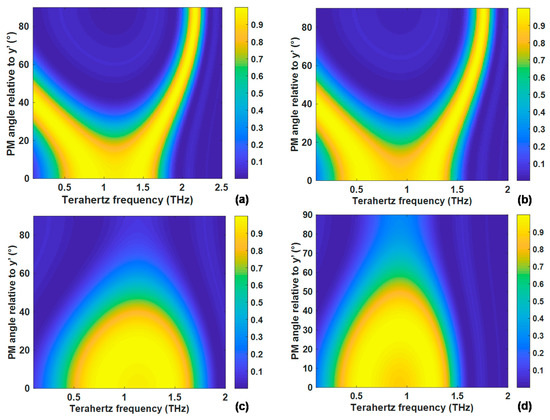
Figure 4.
Relative PM efficiency of collinear angle tuning in ZnTe and CdTe with a 9 kV voltage along the [001] direction: (a,b) are the tuning characteristics in the x’oy′ plane and (c,d) are the tuning characteristics in the y’oz′ plane for ZnTe and CdTe, respectively.
If an inversed electric field (−9 kV) is applied along the z axis, the rotation of the refractive index ellipsoid would be opposite. The angle tuning in the x’oy′ (o−e→e) is similar to that in Figure 4 because the range covers a whole quadrant from the x’ axis to the y’ axis. However, the e−o→o PM in the y’oz’ principal plane is different, as shown in Figure 5. We can see the consistency in Figure 5a,b before tuning and Figure 4a,b after tuning by 90°. The PM conditions in the y’oz′ principal plane shift towards high-frequency terahertz waves for both the ZnTe and CdTe crystals during angle tuning. Meanwhile, the effective nonlinear coefficient is deff = d41 sin(π/2 − θ).
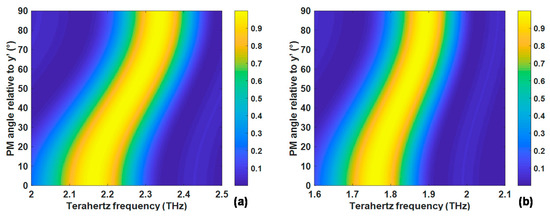
Figure 5.
Relative PM efficiency of collinear angle tuning in the y’oz′ plane of ZnTe and CdTe with a −9 kV voltage along the [001] direction: (a) ZnTe and (b) CdTe.
3.2. Simultaneous Wideband Terahertz Generation Via OR Modulated by the Electro-Optic Effect
Optical rectification (OR) in nonlinear crystals is an effective method for generating wideband terahertz waves excited by ultrashort femtosecond lasers, which motivates the terahertz time-domain systems and various applications [23,24,25,26]. As a second-order nonlinear effect, OR can be described by DFG between different frequency components in the same pulse, but should accommodate the broad bandwidth of the ultrashort pulses. Therefore, group-velocity matching (GVM) is especially important for the OR process because a large PM bandwidth is required. Small group-velocity mismatch also allows the temporal overlapping of the pump and generated terahertz pulses for efficient OR interactions. The coherence length for OR, taking group-velocity dispersion (GVD) into account, is given by
where nopt and λopt are the refractive index and wavelength for the optical waves, respectively.
Considering that the interaction waves propagate along the y’ axis, there are three different types of interactions that provide non-zero deff in nonlinear crystals of the point group—e−o→o, o−e→o, and o−o→e—in the y’oz’ principal plane from the view of DFG. The coherence lengths with and without the applied voltage in ZnTe and CdTe pumped by optical pulses centering at 800 nm and 1010 nm are shown in Figure 6a,b, respectively. Basically, the coherence length is independent of polarization as well as the birefringence induced by the voltage, because neither the optical group refractive index nor the terahertz refractive index in Equation (4) has obvious changes. The large coherence lengths permit both PM and GVM conditions with the crystal thickness at the millimeter level for OR excited by ultrashort laser pulses.
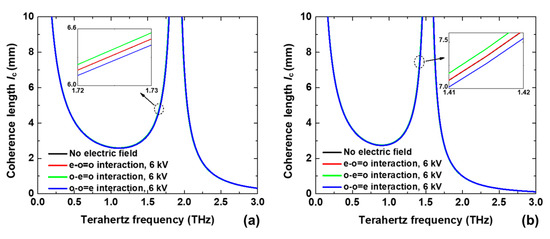
Figure 6.
Coherence lengths of different OR interactions along the y’ axis in the y’oz′ principal plane of ZnTe and CdTe with and without an applied voltage of 6 kV: (a) ZnTe crystal pumped at 800 nm and (b) CdTe crystal pumped at 1010 nm.
Here, 2 mm-long ZnTe and CdTe crystals were used to study the effect of an external electric field on the OR process. Although the GVM varied by the electro-optic effect is not distinct, the PM condition is sensitive to the applied voltage, with the details shown in Figure 7. Compared to Figure 1 without the electric field, the relative PM efficiencies of the e−o→o and o−e→o interactions can be modulated to better fit shorter or longer pump wavelengths, while those of the o−o→e interaction (whose refractive indices of two pump waves are changed synchronously with the same polarizations) remain almost unchanged. This is due to the fact that the angular frequency of the optical wave is around 103 times that of the terahertz wave. Even if the value of the electric-field-induced birefringence is in the order of 10−4, the phase mismatch Δk of the e−o→o and o−e→o interactions is sensitive to the applied voltage whenever two optical pump beams have orthogonal polarizations. From this aspect, a tunable electric field guarantees terahertz generation with a wide bandwidth and minor spectrum fluctuations by better fulfilling both the PM conditions, but not perturbing the GVM condition.
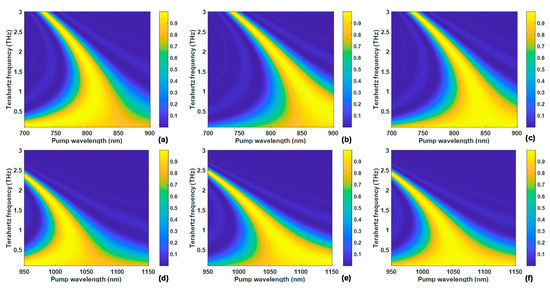
Figure 7.
Relative PM efficiency at three different polarization states of OR in [110]-cut crystals while applying a constant voltage of 6 kV: (a–c) are for ZnTe; (d–f) are for CdTe; (a,d) are the e−o→o interaction; (b,e) are the o−e→o interaction; and (c,f) are the o−o→e interaction.
It should be noted that the OR process here is a combination of the three PM polarization states mentioned above. The incident pump polarization of ψ = 45° to the y’ direction in the y’oz′ plane can be deconstructed to e−o→o and o−e→o interactions uniformly, and their summation would erase the PM difference introduced by the electric field. By contrast, pure difference frequency mixing between two ultrashort laser beams with controllable polarizations would result in a much greater benefit. As mentioned above, the PM efficiency and bandwidth for an arbitrary pump wavelength can be flexibly tuned and effectively optimized by the electro-optic effect in order to produce a broadband and a smooth terahertz spectrum, rather than a spectrum with obvious dips generated by OR [27].
4. Conclusions
A novel method to achieve wideband collinear phase-matched nonlinear optical frequency conversion in cubic crystals was studied in this paper. Based on the linear electro-optic effect, birefringence is induced and the PM characteristics can be varied by tuning the voltage of the applied electric field. The concept was detailed and its detailed performance was evaluated by taking the terahertz generation in ZnTe and CdTe crystals as an example. Simulation results show that tunable monochromatic terahertz waves can be generated under perfect phase-matched DFG over a range of around 2 THz in bulk crystals by changing only the electric field. The restriction to the pump wavelength is eliminated and angle tuning becomes effective for further extending the terahertz frequency range. The effect of the electric field on nonlinear interactions pumped by ultrashort laser pulses was also investigated, which showed that the PM condition of specific polarizations of an arbitrary pump wavelength can be tuned flexibly and optimized to generate a wideband and flat terahertz spectrum without changing the GVM condition. This is the first practical method for realizing collinear phase-matched widely tunable frequency conversion in zinc-blende semiconductors. Tuning the electric field is fast and robust, with a completely unchanged physical construction. The nonlinear crystal can also be made into a compact and high-speed terahertz modulator in addition to a generator, based on the linear electric-optic effect.
Author Contributions
K.Z. and F.L. presented the idea and performed the theoretical analysis. H.Q. and X.Z. investigated the relevant literature and reports. D.X. and J.Y. were responsible for supervision. All authors contributed to the results, discussion, and manuscript writing. All authors have read and agreed to the published version of the manuscript.
Funding
This research was funded by the National Natural Science Foundation of China, grant number 62175184, 61675146, and the Natural Science Foundation of Tianjin City, grant number 18JCYBJC16700.
Institutional Review Board Statement
Not applicable.
Informed Consent Statement
Not applicable.
Data Availability Statement
Not applicable.
Conflicts of Interest
The authors declare no conflict of interest.
References
- Nahata, A.; Weling, A.S.; Heinz, T.F. A wideband coherent terahertz spectroscopy system using optical rectification and electro-optic sampling. Appl. Phys. Lett. 1996, 69, 2321–2323. [Google Scholar] [CrossRef] [Green Version]
- Tanabe, T.; Suto, K.; Nishizawa, J.; Saito, K.; Kimura, T. Tunable terahertz wave generation in the 3- to 7-THz region from GaP. Appl. Phys. Lett. 2003, 83, 237–239. [Google Scholar] [CrossRef]
- Chang, G.Q.; Divin, C.J.; Liu, C.H.; Williamson, S.L.; Galvanauskas, A.; Norris, T.B. Power scalable compact THz system based on an ultrafast Yb-doped fiber amplifier. Opt. Express 2006, 14, 7909–7913. [Google Scholar] [CrossRef] [PubMed]
- Bonvalet, A.; Joffre, M.; Martin, J.L.; Migus, A. Generation of ultrabroadband femtosecond pulses in the mid-infrared by optical rectification of 15 fs light pulses at 100 MHz repetition rate. Appl. Phys. Lett. 1995, 67, 2907–2909. [Google Scholar] [CrossRef]
- Zhong, K.; Shi, W.; Xu, D.G.; Liu, P.X.; Wang, Y.Y.; Mei, J.L.; Yan, C.; Fu, S.J.; Yao, J.Q. Optically pumped terahertz sources. Sci China Technol. Sci. 2017, 60, 1801–1818. [Google Scholar] [CrossRef]
- Powers, P.E.; Haus, J.W. Fundamentals of Nonlinear Optics; CRC Press: Boca Raton, FL, USA, 2017. [Google Scholar]
- Aggarwal, R.L.; Lax, B.; Favrot, G. Noncollinear phase matching in GaAs. Appl. Phys. Lett. 1973, 22, 329–330. [Google Scholar] [CrossRef]
- Nishizawa, J.; Tanabe, T.; Suto, K.; Watanabe, Y.; Sasaki, T.; Oyama, Y. Continuous-wave frequency-tunable terahertz-wave generation from GaP. IEEE Photon. Technol Lett. 2006, 18, 2008–2010. [Google Scholar] [CrossRef]
- Tochitsky, S.Y.; Sung, C.; Trubnick, S.E.; Chan, J.; Vodopyanov, K.L. High-power tunable, 0.5–3 THz radiation source based on nonlinear difference frequency mixing of CO2 laser lines. J. Opt. Soc. Am. B 2007, 24, 2509–2516. [Google Scholar] [CrossRef]
- Li, F.J.; Zhong, K.; Qiao, H.Z.; Liu, K.F.; Zhang, X.Z.; Xu, D.G.; Yao, J.Q. Efficient tunable terahertz generation via noncollinear phase matching in the ZnGeP2 crystal. J. Opt. Soc. Am. B 2020, 37, 3857–3864. [Google Scholar] [CrossRef]
- Petersen, E.B.; Shi, W.; Chavez-Pirson, A.; Peyghambarian, N.; Cooney, A.T. Efficient parametric terahertz generation in quasi-phase-matched GaP through cavity enhanced difference-frequency generation. Appl. Phys. Lett. 2011, 98, 121119. [Google Scholar] [CrossRef]
- Vodopyanov, K.L.; Fejer, M.M.; Yu, X.; Harris, J.S.; Lee, Y.-S.; Hurlbut, W.C.; Kozlov, V.G.; Bliss, D.; Lynch, C. Terahertz-wave generation in quasi-phase-matched GaAs. Appl. Phys. Lett. 2006, 89, 141119. [Google Scholar] [CrossRef] [Green Version]
- Kuo, P.S.; Vodopyanov, K.L.; Fejer, M.M.; Simanovskii, D.M.; Yu, X.; Harris, J.S.; Bliss, D.; Weyburne, D. Optical parametric generation of a mid-infrared continuum in orientation-patterned GaAs. Opt. Lett. 2006, 31, 71–73. [Google Scholar] [CrossRef] [PubMed] [Green Version]
- Mei, J.; Zhong, K.; Wang, M.; Liu, P.; Xu, D.; Wang, Y.; Shi, W.; Yao, J. High-repetition-rate terahertz generation in QPM GaAs with a compact efficient 2-μm KTP OPO. IEEE Photonics Technol. Lett. 2016, 28, 1501–1504. [Google Scholar] [CrossRef]
- Lee, K.F.; Hensley, C.J.; Schunemann, P.G.; Fermann, M.E. Broadly tunable difference frequency generation in orientation-patterned gallium phosphide. In Proceedings of the High-Brightness Sources and Light-Driven Interactions, Long Beach, CA, USA, 20–22 March 2016. [Google Scholar]
- Cui, Z.J.; Liu, D.; Miao, J.; Yang, A.H.; Zhu, J.Q. Phase matching using the linear electro-optic effect. Phys. Rev. Lett. 2017, 118, 043901. [Google Scholar] [CrossRef]
- Li, D.; Ma, G.H. Pump-wavelength dependence of terahertz radiation via optical rectification in (110)-oriented ZnTe crystal. J. Appl. Phys. 2008, 103, 123101. [Google Scholar] [CrossRef]
- Xie, X.; Xu, J.Z.; Zhang, X.-C. Terahertz wave generation and detection from a CdTe crystal characterized by different excitation wavelengths. Opt. Lett. 2006, 31, 978–980. [Google Scholar] [CrossRef]
- Schall, M.; Walther, M.; Jepsen, P.U. Fundamental and second-order phonon processes in CdTe and ZnTe. Phys. Rev. B 2001, 64, 094301. [Google Scholar] [CrossRef]
- Marple, D.T.F. Refractive index of ZnSe, ZnTe, and CdTe. J. Appl. Phys. 1964, 35, 539–542. [Google Scholar] [CrossRef]
- Wu, Q.; Zhang, X.C. Ultrafast electro-optic field sensors. Appl. Phys. Lett. 1996, 68, 1604–1606. [Google Scholar] [CrossRef]
- Hebling, J.; Stepanov, A.G.; Almási, G.; Bartal, B.; Kuhl, J. Tunable THz pulse generation by optical rectification of ultrashort laser pulses with tilted pulse fronts. Appl. Phys. B 2004, 78, 593–599. [Google Scholar] [CrossRef]
- Tomasino, A.; Parisi, A.; Stivala, S.; Livreri, P.; Cino, A.C.; Busacca, A.C.; Peccianti, M.; Morandotti, R. Wideband THz time domain spectroscopy based on optical rectification and electro-optic sampling. Sci. Rep. 2013, 3, 3116. [Google Scholar] [CrossRef] [PubMed] [Green Version]
- Ahn, J.; Efimov, A.V.; Averitt, R.D.; Taylor, A.J. Terahertz waveform synthesis via optical rectification of shaped ultrafast laser pulses. Opt. Express 2003, 11, 2486–2496. [Google Scholar] [CrossRef] [PubMed] [Green Version]
- Sato, M.; Higuchi, T.; Kanda, N.; Konishi, K.; Yoshioka, K.; Suzuki, T.; Misawa, K.; Kuwata-Gonokami, M. Terahertz polarization pulse shaping with arbitrary field control. Nat. Photonics 2013, 7, 724–731. [Google Scholar] [CrossRef]
- Sanjuan, F.; Gaborit, G.; Coutaz, J.-L. Full electro-optic terahertz time-domain spectrometer for polarimetric studies. Appl. Opt. 2018, 57, 6055–6060. [Google Scholar] [CrossRef]
- Hatem, O. Peak emission of terahertz waves from (110)-oriented ZnTe by interacting phase-matched phonon resonances. J. Opt. Soc. Am. B 2019, 36, 1144–1149. [Google Scholar] [CrossRef]
Publisher’s Note: MDPI stays neutral with regard to jurisdictional claims in published maps and institutional affiliations. |
© 2022 by the authors. Licensee MDPI, Basel, Switzerland. This article is an open access article distributed under the terms and conditions of the Creative Commons Attribution (CC BY) license (https://creativecommons.org/licenses/by/4.0/).